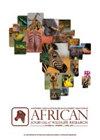雅拉羚羊在资源生产力梯度上对植被绿度的选择
IF 1
4区 环境科学与生态学
Q2 Agricultural and Biological Sciences
引用次数: 0
摘要
植物生产力的地理梯度可以呈现出在种群范围内具有不同资源水平的觅食大型食草动物,个体可以表现出不同的选择强度。为了研究尼亚拉羚羊(Tragelaphus angasii)对植被绿化的个体特异性反应,我们在南非Hluhluwe-iMfolozi公园用8只带遥测圈的成年雌羚羊对景观进行了监测,其中一半在湿润端,一半在干燥端。我们利用植被植被的遥感绿化率作为植物生产力的指标和冠层结构数据,比较了不同平均绿化率的动物对植被的选择强度。结果表明,本区平均绿度与选择强度之间呈下降趋势,这取决于季节和树冠的存在。低绿度原生地的动物在旱季对封闭冠层植被有更强的正向选择;湿季高绿度原始区对开冠植被的负选择倾向较强。我们的研究强调,景观上的空间资源梯度可能为资源的时间变化提供一个有价值的模型,并表明觅食动物适应这些变化的潜力。本文章由计算机程序翻译,如有差异,请以英文原文为准。
Selection of Vegetation Greenness by Nyala Antelopes on a Resource Productivity Gradient
Geographic gradients in plant productivity can present foraging large herbivores with varying resource levels across the range of a population, to which individuals can demonstrate varying intensity of selection. To investigate individually-specific responses of nyala antelopes (Tragelaphus angasii ) to vegetation greenness, we monitored the landscape use of eight telemetry-collared adult females, half at the wetter end and half at the drier end of Hluhluwe–iMfolozi Park, South Africa. We used remotely-sensed greenness as an index for plant productivity and data on canopy structure, and we compared the strength of selection for greenness between animals having different greenness averages within their home ranges. We found a decreasing pattern between home-range average greenness and strength of selection, which depended on season and presence of tree canopies. Animals in low-greenness home ranges tended to have stronger positive selection in closed-canopy vegetation in the dry season; those in high-greenness home ranges tended to have the stronger negative selection in open-canopy vegetation in the wet season. Our study emphasizes the possibility that a spatial resource gradient on a landscape might provide a valuable model of temporal change in a resource and an indication of potential for foraging animals to adapt to those changes.
求助全文
通过发布文献求助,成功后即可免费获取论文全文。
去求助
来源期刊

African Journal of Wildlife Research
Multiple-
自引率
0.00%
发文量
14
期刊介绍:
The African Journal of Wildlife Research is an ISI ranked, leading peer reviewed scientific publication in wildlife research in Africa, Arabia and Madagascar, with a broad base covering scientific, applied, managerial, methodological and sociological issues related to wildlife research. The journal publishes original full-length scientific papers, short communications, book reviews as well as reviews on science-based research invited by the editor-in-chief. This research journal and has been published annually since 1971.
Until 2014 (Volume 44) the journal was known as the South African Journal of Wildlife Research and from 2015 (volume 45) the name changed to African Journal of Wildlife Research. The journal reaches a wide readership, including both local and foreign wildlife managers, academics and wildlife owners, and libraries local and abroad. It is an important reference for anyone interested in the management and sustainable utilisation of natural resources.
 求助内容:
求助内容: 应助结果提醒方式:
应助结果提醒方式:


